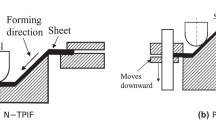Abstract
Incremental sheet forming (ISF) has received increasing attention with its advantages of economy and flexibility for small batch sheet metal parts. However, the excessive thinning may be resulted at large forming angles for complex parts, which cannot meet the design requirements and seriously impedes the industrial application of ISF. Although the multistage incremental sheet forming (MISF) has been proposed to overcome the dilemma of excessive thinning in ISF, the design of the optimal strategy which can control material flow and improve thickness distribution is a critical issue. In this paper, three promising multistage two point incremental sheet forming (MTPIF) path strategies, i.e., parallel line strategy, variable angle strategy, and stretch-bend-assisted strategy, are selected to investigate the influence of tool paths on thickness distributions, material flow, and geometric error. Firstly, experimental thickness distributions of truncated pyramids formed with three path strategies and single-stage TPIF strategy are compared. Meanwhile, the theoretical models are introduced to illustrate the difference of thickness distributions both at the wall and the corner. Compared with single-stage TPIF strategy, MTPIF path strategies studied in this paper are effective to improve the thickness distribution of truncated pyramids at both the component wall and the corner. Through the theoretical analysis, it is found that the thickness distribution at the wall can be controlled by adjusting intermediate forming angles. Meanwhile, the intermediate shape in circumferential direction has significant influence on the thickness distribution for complex parts. Then, the material flows of three path strategies at different forming stages are analyzed. It is found that the materials at the flange as well as transition arcs are deformed into wall to increase the thickness distribution. Finally, considering both thickness distributions and geometric errors, the variable angle strategy is found as the effective MTPIF strategy for the studied process.















Similar content being viewed by others
References
Altan T, Tekkaya AE (2012) Sheet metal forming processes and applications. ASM International, Ohio
Esmaeilpour R, Kim H, Park T, Pourboghrat F, Mohammed B (2017) Comparison of 3d yield functions for finite element simulation of single point incremental forming (SPIF) of aluminum 7075. Int J Mech Sci 133:544–554
Esmaeilpour KH, Park T, Pourboghrat F, Xu Z, Mohammed B, Abu-Farha F (2018) Calibration of Barlat Yld2004-18P yield function using CPFEM and 3D RVE for the simulation of single point incremental forming (SPIF) of 7075-O aluminum sheet. Int J Mech Sci 133:24–41
Esmaeilpour R (2018) Finite element simulation of single point incremental sheet forming with barlat 2004 yield function, cpfem, and 3d rve, Ph.D. thesis, The Ohio State University
Kim TJ, Yang DY (2000) Improvement of formability for the incremental sheet metal forming process. Int J Mech Sci 42(7):1271–1286
Duflou JR, Verbert J, Belkassem B, Gu J, Sol H, Henrard C, Habraken AM (2008) Process window enhancement for single point incremental forming through multi-step toolpaths. CIRP Ann Manuf Technol 57(1):253–256
Liu Z, Li Y, Meehan PA (2013) Vertical wall formation and material flow control for incremental sheet forming by revisiting multistage deformation path strategies. Adv Manuf Process 28(5):562–571
Skjødt M, Bay N, Endelt B, Ingarao G (2008) Multi stage strategies for single point incremental forming of a cup. Int J Mater Form 1(1 Supplement):1199–1202
Malhotra R, Bhattacharya A, Kumar A, Reddy N, Cao J (2011) A new methodology for multi-pass single point incremental forming with mixed toolpaths. CIRP Ann Manuf Technol 60(1):323–326
Kitazawa K, Nakajima A (1997) A method for producing aluminum cylindrical shell having uniform wall-thickness by CNC incremental forming process. J Jpn Inst Light Met 47(7):378–384
Hirt G, Ames J, Bambach M, Kopp R (2004) Forming strategies and process modelling for cnc incremental sheet forming. CIRP Ann Manuf Technol 53(1):203–206
Liu Z, Daniel WJT, Li Y, Liu S, Meehan PA (2014) Multi-pass deformation design for incremental sheet forming: analytical modeling, finite element analysis and experimental validation. J Mater Process Technol 214(3):620–634
Chuanlin A, Wang H, Gao L, Wang D (2016) Experimental study on the incremental forming assisted bending and stretching strategy for vertical walls parts. Mech Scie Technol Aerospace Eng 35(3):420–424
Liu Z, Li Y, Meehan PA (2014) Tool path strategies and deformation analysis in multi-pass incremental sheet forming process. Int J Adv Manuf Technol 75(1–4):395–409
Xu D, Malhotra R, Reddy NV, Chen J, Cao J (2012) Analytical prediction of stepped feature generation in multi-pass single point incremental forming. J Manuf Process 14:487–494
Cao T, Lu B, Xu D, Zhang H, Chen J, Long H, Cao J (2015) An efficient method for thickness prediction in multi-pass incremental sheet forming. Int J Adv Manuf Technol 77:469–483
Isik K, Silva MB, Tekkaya AE, Martins PAF (2014) Formability limits by fracture in sheet metal forming. J Mater Process Technol 214(8):1557–1565
Soeiro JMC, Silva CMA, Silva MB, Martins PAF (2015) Revisiting the formability limits by fracture in sheet metal forming. J Mater Process Technol 217:184–192
Bambach M (2010) A geometrical model of the kinematics of incremental sheet forming for the prediction of membrane strains and sheet thickness. J Mater Process Technol 210(12):1562–1573
Li Y, Chen X, Liu Z, Sun J, Li F, Li J, Zhao G (2017) A review on the recent development of incremental sheet-forming process. Int J Adv Manuf Technol 92:1–24
Funding
The authors thank the support from the National Natural Science Foundation of China (51575028), National Natural Science Foundation of China (51605258) and the Fundamental Research Funds for the Central Universities (YWF-18-BJ-J-75). Also, the authors thank the suggestions of editors and reviewers.
Author information
Authors and Affiliations
Corresponding author
Additional information
Publisher’s note
Springer Nature remains neutral with regard to jurisdictional claims in published maps and institutional affiliations.
Rights and permissions
About this article
Cite this article
Li, X., Han, K., Xu, P. et al. Experimental and theoretical analysis of the thickness distribution in multistage two point incremental sheet forming. Int J Adv Manuf Technol 107, 191–203 (2020). https://doi.org/10.1007/s00170-020-05037-y
Received:
Accepted:
Published:
Issue Date:
DOI: https://doi.org/10.1007/s00170-020-05037-y




